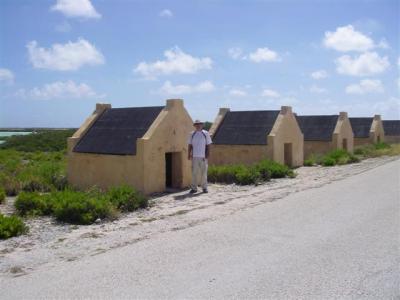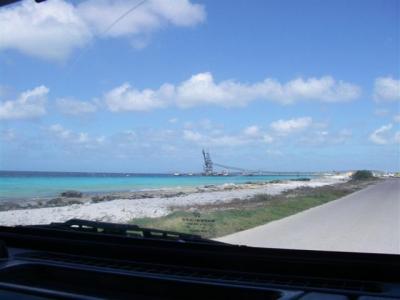Continued from yesterday”¦ Near where the wetlands turned into Luc Bay, the salt pans started. Almost all of the south side of the island is owned by the salt company, and there are miles upon miles of salt drying “pans”, which are large, shallow troughs of water dug into the ground. As we drove south, we found ourselves on a narrow strip of land. To our left was the ocean and to our right were the pans.
There were quite a few flamingos grazing in the salt pans, all out in the distance, of course. The flamingos feed on brine shrimp, crustaceans, plankton and algae, which are all easily accessible in the shallow pools. We know that deeper in the salt flats is a flamingo sanctuary, one of the four main breeding sites for the entire Caribbean flamingo population. There is no road to get there, it is strictly off limits to the public, and it is too far from the road for people to see them. It sounds like the flamingos here regularly fly back and forth from Venezuela.
On the windward side of the ocean there were huge waves pounding the shore. We passed a lighthouse at the southernmost point of the island. As we came around the bottom of the island towards the leeward side, we saw the infamous slave huts. They are situated just at the edge of where the surf dies down, close to the lighthouse. Beyond the huts, on the ocean, there were some kite boarders skimming along the water, just like the day we arrived on Kosmos. It is really quite scenic.
The huts are almost shocking. They were built in the 1850’s, and were apparently an upgrade from the mud huts that were used prior. Several people were crowded into these shelters. As you can see, they are tiny — barely long, wide and tall enough for someone short to stand up/lay down in. Putting two people in one of those would be “cozy”, particularly if one of them was tall, and apparently many people were crowded into each of them.

The salt mining work was hard — slaves used wheelbarrows, shovels and picks to mine the salt in the burning sun. Ships picking up the salt would anchor off the coast. The slaves would load basketfuls of salt into dinghies and deliver the salt to the ships.
As the road continued north, the salt pans changed in color from clear to purple. It is kind of surreal to see purple pools of salt, but cool looking none-the-less. We passed numerous trucks pulled over on the side of the road, clearly divers who are doing shore entries. We passed mountains of (white) salt piled up near an interesting looking, roller coasteresqe contraption that moves salt to a dock where ships can tie up. It amazes us that the mountains haven’t melted away in all the rain.


The mountains and contraption must mark the Continue reading
